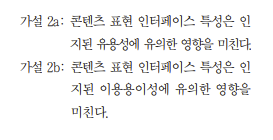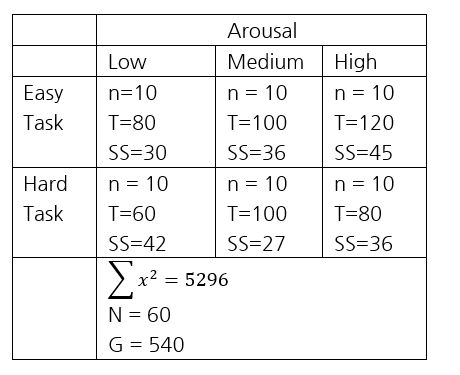Table of Contents
Week01
(Sep 4, 7)
regression lecture note
ideas and concepts
Using theories
- 연구문제와 가설 and
- making hypotheses
- 가설 예1
Installing R
Using a data set: mtcars
Assignment
Week02
(Sep 11, 14)
Concepts and ideas
동영상 시청. 아래 동영상은 교재의 2장 이후를 다루는 내용이면서 계산적인 통계에 대해서 공부하기 위해서 꼭 필요한 내용이므로 숙지하시기 바랍니다. 동영상이 길어서 이 부분은 3주차에도 계속 시청합니다.
- 간단한 예로서의 평균 (mean)
- 제곱합 (오차의제곱합, 혹은 이탈의제곱합 혹은 deviation score의제곱합)
-
- 모집단 추정을 위해서 n-1 사용을 하는 이유
- 샘플평균들의 집합
- Sampling Distribution 혹은 Distribution of Sample Means
- Standard Deviation of Sample Means
- Standard Error, 표준오차
- Central Limit Theorem (Central Limit Theorem)
- 예측에서의 (평균이 어디에서 나올까의 예측) 신뢰구간
- 검정통계
$$ \text{Inferential Statistics} = \frac {\text{Effects}} {\text{Error}} $$
실제차이를 랜덤차이로 나눈 비율

\begin{eqnarray*}
s^2 & = \frac {SS}{df} \\
\sqrt{s^2} & = s
\end{eqnarray*}
Activities
Group forming
- random assignment?
- voluntary formation?
Assignment
Week03
(Sep 18, 21)
Activities
Grouping (꼭 할 것)
Group self-registration at ABB
Group membership adjustment
Concepts and ideas
영상
Knowledge to understand hypothesis testing
- Sampling distribution or Distribution of the sample mean or Distsribution of sample means
-
Assignment
Group Assignment
가설 만들어 보기
- SNS에서의 그룹극화는 (Group Polarization) 어떻게 일어날까?
- Youtube에서의 콘텐츠노출은 어떻게 극화가 될까?
- filter bubble: Search engine or curating algorithm leads an individual to intellectual or ideological isolation because they feed them information one would agree. (see https://reutersinstitute.politics.ox.ac.uk/news/truth-behind-filter-bubbles-bursting-some-myths)
- 그러나, 검색엔진이나 추천알고리즘이 선택을 정해준다기 보다는
- 다양한 내용의 선택에도 자신의 선호경향의 내용만을 선택하기 때문에 일어나지 않을까?
- 그렇다면, 이를 어떻게 알아볼가 (검증할까?)
- 극화된 의견만 표출되는 경향으로 대중의 공공의견이 (public opinion) 왜곡되는 경향이 있다.
- 의견이 불분명하거나 아직 확실하지 않은 사람은 의견표출이 없는 경향을 갖고 있으며
- 극단치의 의견만이 표면에 들어나게 된다.
Week04
(Sep 25, 28)
영상
문서 + 텍스트
Class Activity
out of class
- intervene –
- inter + ven(e) = between + come
- prevent
- convention
- convene
- revenue
- venue : place people to come
- convenient : to come together → suit → fit
- adventure : things about to happen (곧 일어날 일)
- invention : into + come : about to know : discovered
- event
—-
Hypothesis
- 가설 만들어 보기
- No need to read theories
-
- 원 이론은 사람들은 다른 사람들의 생각, 의견에 대한 파악이
- 무의식적이지만 체계적으로 혼돈없이 잘 일어날 것을 가정한다.
- 그렇다면 이것이 온라인에서는 어떨까?
- 온라인에서 소수의 아이디어를 가진 사람이나 집단이
- 다수인 양 한다면 이것이 오프라인에 일어날 때 보다
- 더 효과적이지 않을까?
- 위의 생각에 기반한 가설은 어떻게 세울 수 있을까?
- Read hypothesis
- how to write hypothesis at behavioral science writing.
- One sample hypothesis Hypothesis at www.socialresearchmethods.net
from https://www.verywellmind.com/what-is-a-hypothesis-2795239
kinds of hypothesis
- Students who eat breakfast will perform better on a math exam than students who do not eat breakfast
- Identify and its level of measurement (lom, 측정수준):
- IV
- IV's lom
- DV
- DV's lom
Concepts and ideas
Assignment
Assignment for all
- Read 커뮤니케이션_연구문제_제기와_가설
- Read research question
- Read hypothesis
Group assignment 1 (ma.22.w04.ga.id.var)
- 파일로 과제를 제출할 경우, ma.22.w04.ga.id.g그룹번호.docx 와 (예, ma.21.w04.ga.id.g02.odc) 같이 제출하세요.
- Hypothesis 문서의 예의 “제3자 효과이론과 침묵의 나선이론 연계성” 논문을 읽고 가설을 기술하시오.
- 각 가설의 독립변인(Independent variables), 종속변인 (dependent variables) 등을 나열하시오.
- 이 논문에 사용된 이론은 무엇인지 기술하고 설명하시오.
Group assignment 2 (ma.22.w04.ga.making.ttest.h)
가설 만들어 보기
t-test (ma.22.w04.ga.making.ttest.h) – t-test 동영상 시청을 마치고 하세요.
- 파일제출시에는 ma.22.w04.ga.making.ttest.h.g10.docx와 같이 하세요.
- 모든 가설은 자기 조의 관심사와 관련이 있어야 합니다.
- 모집단 평균과 표준편차를 알고 있을 경우의 가설
- 두번째 종류는 생략
- 모집단의 파라미터를 모르는 두 집단의 평균과 표준편차만을 알고 있을 경우의 가설
- 반복측정 가설
Week05
(Oct 2, 5)
ideas and concepts
영상 시청 (8주차까지 볼 동영상입니다)
ideas and concepts
correlation
regression
multiple regression
이하는 다음 주에
Partial and semipartial correlation
using dummy variables
Statistical Regression Methods
Sequential Regression
Assignment
Week06
ideas and concepts
Assignment
- Public opinion in online environments 1)
- etc. 여론형성과 관련된 사회학적 혹은 사회심리학적 이론을 찾아보고 소개하기, 예로 위의 세가지. 얼마전 사회현상을 어떻게 설명하면 좋을까에 대해서 논의정리하기? 정확한 온라인 환경에서의 여론파악을 위해서 어떤 것이 필요할까?
- 혹은 다른 문제에 대해서 (. . . 조에 따른 . . .)
- Hypotheses
- Multiple regression hypotheses.
- Google Survey Questions
Week07
(Oct 16, 19)
- standardized coefficient in r (beta coefficient in mr)
- lm.beta(model)
lm.beta(m.sa.ytfbnp)
Activity
- 데이터 불러오기
dat <- read.csv("http://commres.net/wiki/_media/regression01-bankaccount.csv")
- 살피기
str(dat) - 가설만들기 : 독립변인으로 fammember를, 종속변인으로 account를 (통장갯수를)
- ?
- 변인관련 실습
- DV의 SS 값은 무엇인가?
- DV의 df 값은 무엇인가?
- DV의 Variance는 무엇인가?
- IV와 DV의 Covariance 구하기
- SP?
- df?
- correlation coefficient값은?
- SSreg 값은?
- SSres 값은?
- r square 값은?
- F test 값은?
- Regression test
dat.lm <- lm(account~fammember, data=dat)
Assignment
Week08
Week09
(Oct 30, Nov 2)
ideas and concepts
영상
- Partial and Semipartial Correlation in Multiple Regression
- Semipartial Correlation in Multiple Regression
- Dummy Variables in Multiple Regression
- Beta Coefficient in Multiple Regression
correlation
regression
multiple regression
Partial and semipartial correlation
dummy variable in r
Statistical Regression Methods
Sequential Regression
Activity
Assignment
Week10
Assignment
Group Activity
- 마감은
11월12일 일요일11월 14일 자정까지입니다 (아주비비 공지사항대로). 아주비비의 토론게시판에 올려 주시기 바랍니다. - 게시글 제목 형식: Gruop04 를 예로 들면 아래와 같이 작성하세요.
- [Group04] 요인분석 연습
- 본문은 직접 작성하거나 아니면 워드프로세서 (아래한글 제외) 작성해도 됩니다.
- 단 폰트는 fixed-width font를 꼭 사용해야 합니다. D2Coding, 나눔고딕코딩 글씨체 등을 말합니다.
직접 게시글을 작성한다면 한글글씨체 옵션이 없기 때문에 Courier New 체를 사용하면 됩니다.- 분석과정과 아웃풋을 같이 제시하고 해석을 (해석하게 된 이유도 제시) 해야 합니다.
- 글을 게시하기 이전에는 다른 조의 (사람들의) 글을 읽을 수 없습니다. 먼저 읽어보려고 임시 게시글을 올리지 마세요.
- 과제데이터는 Factor Analysis # excersize 참조하세요
- Data importing and initial analysis: 기본적으로 아래를 수행하여 보고 시작해 보세요. eigen value 값 1은 가이드라인이지 절대적으로 정해진 것은 아닙니다.
library(psych)
saq <- read.csv("http://commres.net/wiki/_media/r/saq.csv", header = T)
head(saq)
round(cov(saq),2)
saq.fa <- fa(saq, rotate="none") # fa test with no rotation
saq.fa # This output would have only one factor, not useful.
names(saq.fa) # to see what comes with the output d.fa
# e.values = eigen values for (possible) factors
plot(saq.fa$e.values, type='b')
saq.fa$e.values
- rotation methods
- 여러가지 rotation 방법을 쓰기위해서는 아래를 인스톨해야 합니다.
install.packages("GPArotation")
library(GPArotation)
- orthogonal = 직각 교차 (rotation) = 요인 간 상관관계가 없도록 회전하는 것
- oblique = 상관관계 허용
- varimax를 가장 많이 써왔음
- oblique 중에서는 oblimin 이 가장 많이 쓰임
- fa 평션의 경우, oblimin 이 default라고 함 (아닐 수도 있음)
orthogonal rotations: "none", "varimax", "quartimax", "bentlerT",
"equamax", "varimin", "geominT" and "bifactor"
oblique transformations of the solution: "Promax", "promax", "oblimin",
"simplimax", "bentlerQ, "geominQ" and "biquartimin",
"cluster"
Week11
Assignment
Week12
(Nov 20, 23)
Social Network Analysis in R space
ideas and concepts
Assignment
Week13
(Nov 27, 30)
ideas and concepts
fa
- model fit
- chi-sqaure test
- RMSE of Approximation
- GOFI (Goodness of Fit Index) or Adjusted GOFI
- factor score
- latent idea (variable): i.e., IQ
social network analysis
social network analysis tutorial
sna in r
Stanford University egs.
announcement
- 두번째 시간 퀴즈 03
- 범위
- 통계방법 선택하기
- ANOVA
- Factorial ANOVA
- Correlation
- Regression
- Multiple regression
- Partial and semipartial correlation
- Using dummy variable
- Mediation Analysis
- Path Analysis
- Factor analysis
Assignment
Week14
(Dec 4, 7)
insurance.csv
Group Assignment
가설 만들기
- 자신의 전공과 관련 있는 아래를 만들어 보세요.
- 멀티플 리그레션 사용할 수 있는 모델 만들기
- 경로분석 할 수 있는 모델 만들기
- 데이터 수집에 대해서 설명하기
- 각 변인은 무엇인지
- 각 변인을 어떻게 측정할 것인지
Week15
(Dec 11, 14)
Mediation Analysis
Week16
(Dec 18, 21)
Final-term covers:
계산문제를 제외하고 어떤 상황에서 어떤 통계방법을 써야하는지에 대해서와 아웃풋을 해석하거나 아웃풋에서 답을 유추하는 문제 등은 아래 범위에서 나올 수 있습니다.
t-test, ANOVA, Factorial ANOVA
그 외에 수업시간에 다룬 부분은 또한 포함합니다.
correlation
regression
multiple regression
partial and semipartial correlation
using dummy variables
factor analysis
social network analysis
sna tutorial
sna in r
SNA e.g. lab 06
Some R outputs will be used to ask the related concepts and ideas (the above).






